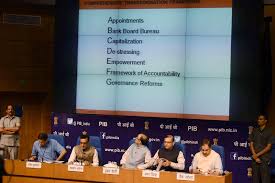Finance minister Arun Jaitley launched a seven pronged plan called Indradhanush in August 2015. The mission is also known as A2G for public sector banks.
Mission of the plan: To revamp or improve the functioning of public sector banks. Indradhanush mainly focuses on systemic changes in state-run lenders, including a fresh look at hiring, a comprehensive plan to de-stress bloated lenders, capital infusion, accountability incentives with higher rewards including stock options and cleaning up governance.
The plan is called Indradhanush because it contains seven elements as:
- Appointments: Executives from the private sector have been hired to run state-owned banks. Separate post of CMDs and MD & CEO in PSU. Private sector candidates can also apply for the position of MD & CEO.
- Bank Board Bureau: It will replace existing appointments board. Click here to read about Bank Board Bureau.
- Capitalization: Under recapitalization plans for Public Sector Banks, 13 banks would get Rs 20,058 crore this financial year. The rest Rs 5,000 crore would be allocated based on efficiency criteria. SBI will get the highest Rs 5,511 cr, followed by Bank of India at Rs 2,455 cr, IDBI at Rs 2,229 cr, PNB at Rs 1732 cr and IOB at Rs 2009 cr.
- De-stressing: The focus will be on de-stressing the banks from their Non-Performing Assets or Bad Loans. Asset reconstruction companies would also be strengthened to deal with the bad loan situation.
- Empowerment: Under this, the government will make it easier for PSBs to hire. The government is looking at introducing Employee Stock Ownership Plan (ESOPs) for the PSU bank managements.
- Framework of Accountability: The government also announced a new framework of key performance indicators for state-run lenders to boost efficiency in functioning while assuring them of independence in decision making on purely commercial considerations.
- Governance Reforms: The process of governance reforms started with “Gyan Sangam” – a conclave of PSBs and Financial Institutions organized at the beginning of 2015 in Pune which was attended by all stake-holders including Prime Minister, Finance Minister, MoS (Finance), Governor, RBI and CMDs of all PSBs and FIs. The Gyan Sangam recommendations included strengthening of risk management practices. Each bank agreed to nominate a senior officer as Chief Risk Officer of the bank.
Indradhanush 2.0:
Government came out with ‘Indradhanush 2.0’, a comprehensive plan for recapitalisation of public sector lenders, with a view to make sure they remain solvent and fully comply with the global capital adequacy norms, Basel-III.

